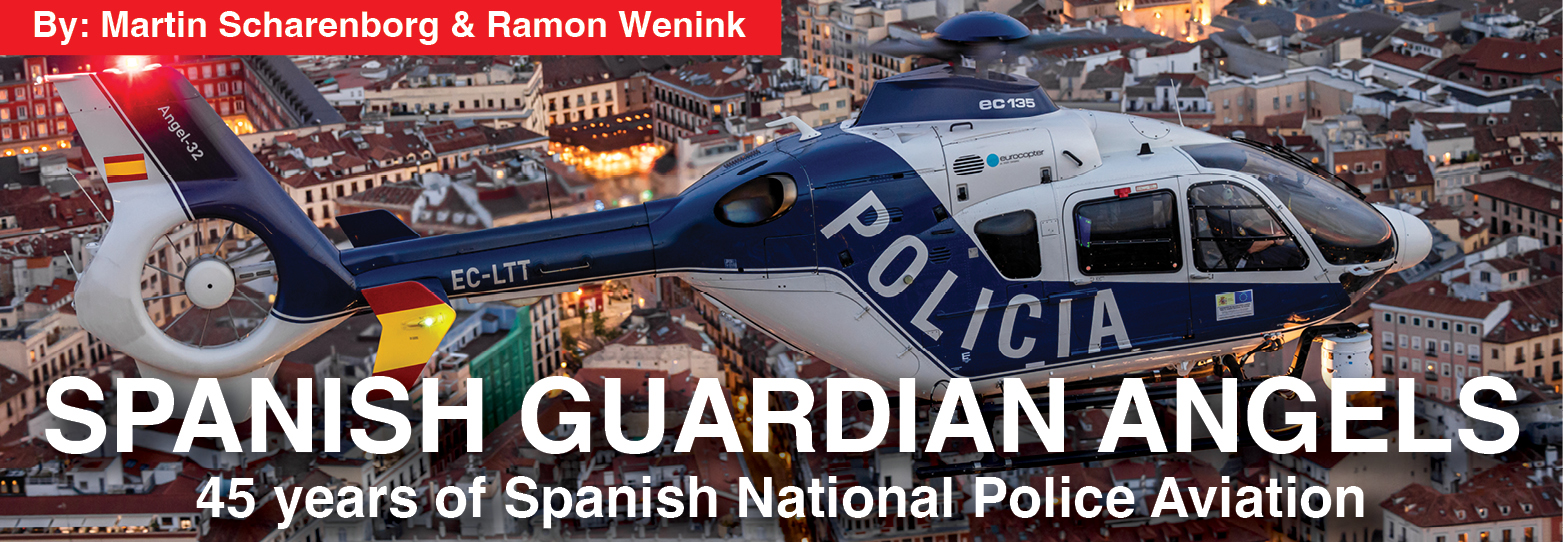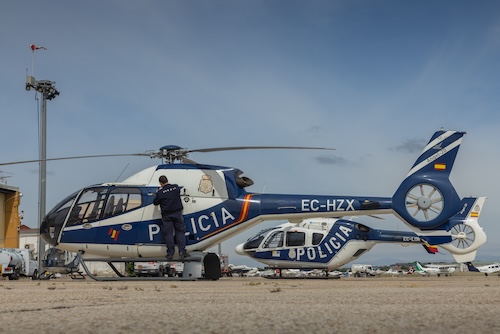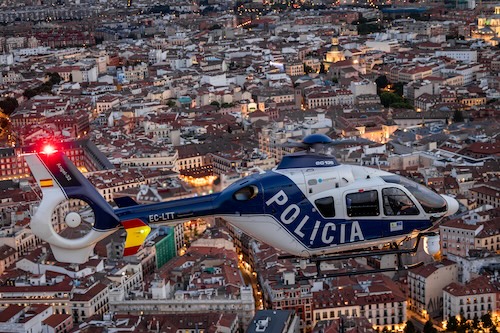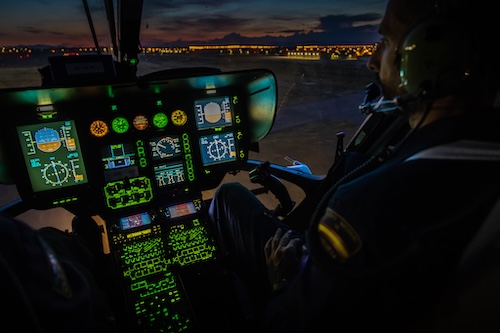|
Aug
05
2024
|
|
Posted 1 years 129 days ago ago by Admin
|
|

Last year there was an exuberant atmosphere in Madrid. Thousands of people are flocking to the city center to welcome their football club, Real Madrid, after their victory in the UEFA Champions League final. The Spanish police have mobilized massively to ensure the smooth conduct of this event. Additionally, from the air, a helicopter is vigilantly keeping an eye on potential risks and incidents and relaying information to ground units. This year, the Spanish police will celebrate their 200th anniversary, and the aviation department will mark its 45th birthday. This milestone prompted Martin Scharenborg & Ramon Wenink/Global Aviation Review Press to take a look behind-the-scenes at this busy unit.
In Spain, various organizations are responsible for law enforcement. The two main ones are the Guardia Civil, comparable to military police, and the Cuerpo Nacional de Policía (CNP). Both operate under the Directorate General of Police (Dirección General de la Policía) and report to the Ministry of the Interior. The Guardia Civil primarily operates in rural areas, while the Cuerpo Nacional de Policía mainly operates in and above large urban areas, as well as on Spanish islands and enclaves. Additionally, separate police units (Policía Autonomica) are established in autonomous regions such as Catalonia, the Basque Country, and Navarra. Due to overlapping responsibilities, strong collaboration exists among these police units.
With almost 48.5 million inhabitants and 4,964 kilometers of coastline, of which 1,670 kilometers border the Mediterranean Sea, Spain is the second-largest country in Europe. Recognizing the need for effective law enforcement, the decision was made early on to equip the police units (Guardia Civil and Cuerpo Nacional de Policía) with helicopters. In 1975, two Alouette II helicopters were acquired, leading to the establishment of the Servicio de Medios Aéreos (SMA), the aviation department of the Cuerpo Nacional de Policía, in 1979.

Responsibilities
The SMA's responsibilities have grown over the years, including supporting the Judicial Police, providing intelligence, ensuring public safety, immigration control, assisting the Scientific Police (forensics), and providing Helicopter Emergency Medical Service. The main operating base of the SMA is at Cuatro Vientos airbase in the south of Madrid. There are also permanent detachments in Vigo, Zaragoza, Valencia, Malaga, Sevilla, and on Gando (Gran Canaria) and Son Sant Joan (Mallorca). Spain, situated near the Mediterranean Sea, faces challenges related to illegal migration and drug trafficking, and is contributing significantly to 'FRONTEX' (The European border and coast guard agency) activities, and therefore regularly uses detachments on the enclaves Melilla and Ceuta on the North African mainland, on Gibraltar and on the Balearic Isles.
Mixed Fleet
The Sud Aviation SA-318C Alouette II helicopters were gradually replaced by Messerschmitt-Bölkow-Blohm Bö-105CBs from 1985 onwards, with a total of 12 in service. The Bö-105CBs were gradually phased out from 2003 onwards, with eight remaining active until the delivery of the last of the 16 newly ordered Eurocopter EC-135P2/P2+ (H135) helicopters by Airbus in Albacete. The last Bö-105CB was officially decommissioned in January 2023 at Dakar Airport in Senegal. The SMA maintained a permanent detachment there with a Bö-105CB helicopter since early 2007, monitoring immigration, human trafficking, and drug smuggling. The Bö-105CB was very popular among the pilots and was considered the workhorse of Spanish police aviation.
Since 2001, the SMA also operates two EC-120 (H120) Colibri helicopters, primarily used for training due to their single Arrius 2F turbine engine. Occasionally, they are used for observation flights but not above urban areas due to the single engine and associated restrictions. To transport special units such as the Gruppo Especial de Operaciones (GEO), a larger helicopter was needed. The EC225LP (H225) Super Puma was chosen, and one helicopter was eventually delivered in late 2010. However, due to high maintenance costs, it was transferred back to Airbus in Albacete after a year and eventually sold to the Botswana defense force in 2016.

In 2003, the SMA obtained its first fixed-wing aircraft, a Beech 200GT Super King Air, seized during a police operation. Another aircraft, a Cessna C550 Citation II, was seized in 2009, belonging to Marbella Airways, but used by a criminal associated with corruption and drugs. Both aircraft are still in use by the SMA, primarily for transporting special police units, prisoner transport, and deporting immigrants. The two fixed-wing aircraft are stationed at Aeropuerto Madrid Cuatro-Vientos. To fly and maintain the fleet of helicopters and aircraft; SMA currently has approximately 50 pilots, 55 technical personnel, and 40 system operators.
Approved Training Organization
"To serve in the SMA, a future pilot must first become a police officer or already be one with the Cuerpo Nacional de Policía (CNP) because a pilot with a police background better understands what is expected of them in the air," says Chief Inspector Martin, a pilot at the SMA on Cuatro Vientos Airbase. With no prior flying experience, he began his pilot training in 2005. After obtaining his ATPL-frozen, he served on the MBB Bö-105 and became pilot in command after accumulating 500 flying hours as a co-pilot. Upon reaching 1,000 flying hours, he became an instructor, handling aircraft like the H120, H135 and H225. Over the years, he has been the head of European operations, coordinating SMA operations in Senegal and for FRONTEX. He has amassed an impressive 3,600 flying hours within the SMA.
Martin explains, "Until 1989, our aspiring pilots received their initial training from our colleagues in the Spanish air force on the H120 at the Armilla airbase. Now, the SMA is an Approved Training Organization (ATO) designated by the European Agency Safety Agency (EASA). This means we can conduct the entire training in-house. Selected pilots start with 1,100 hours of theory before entering the simulator (FNPT-II) for the H135. Subsequently, they undergo 120 hours of actual flight training on the H120. After successfully completing this first phase, pilots train for realistic police missions, combining the H120 and H135. This phase takes about 180 flying hours, with 90 hours on the H120 and 90 hours on the H135. After flying 500 hours as a co-pilot, pilots can progress to become pilot-in-command (PIC) and eventually an instructor. We also train technicians, and we are fully authorized by EASA for this too."
Reinforcements
In 2021, a contract was signed between the General Directorate for Armaments and Materiel (DGAM) and Airbus for the delivery of 36 new H135P3s for the Spanish Ministry of Defense and the Ministry of the Interior. Out of the 18 designated for the Ministry of the Interior, nine are allocated to the Cuerpo de Guardia Civil, and nine to the Cuerpo Nacional de Policía. "We need these aircraft for the many tasks we have to perform at various locations in the country. Furthermore, the new aircraft are equipped with fast roping capability for the operative team, making them an excellent addition," says Martin.

The H135 helicopters of the SMA are well-equipped for their tasks and can be fitted with the Spectrolab SX-16 Nightsun, facilitating the detection of possible suspects on the ground. Additionally, the aircraft can be equipped with cameras that transmit real-time images to the command center and ground units. Currently, two types are in use: the 'FSI Ultra Media III system,' mainly used during daylight, and since 2017, the FLIR Surveillance Inc. 'STAR SAFIRE 380HD' forward looking infrared camera. "Due to budgetary reasons, not all H135s are equipped with this yet, but the goal is to outfit most aircraft with this new system," Martin explains. The H135s also feature GPS integrated mapping, stabilized binoculars, NVG ANVIS-9, rappel and fast roping capability, and a rescue crane.
Unmanned Aerial Systems
A unique addition to the SMA's inventory is the 'EHang EH216.' This Autonomous Aerial Vehicle (AAV) is capable of electronic takeoff and landing (eVTOL). The aircraft can carry up to two passengers, reach a maximum speed of 130 km/h (approx. 80 mph) at an altitude of 3,000 meters (approx. 9,842 feet), and has a range of approximately 35 kilometers (approx. 22 miles). In October 2021, a collaboration between Ehang Holding Ltd. and the Cuerpo Nacional de Policía was signed to explore the possibilities of this AAV for use in rescue and security missions, as well as the transportation of prisoners. The first flight by the SMA took place in December 2022. The project is currently awaiting continuation while the vehicle is in storage at the SMA's hangar at Cuatro Vientos Airport.
Smaller unmanned aircraft, or UAV/UAS (unmanned aerial vehicles/systems), are becoming more common and often fly over areas where they pose a direct threat to safety. A special unit within the SMA actively monitors legal and illegal drone use above cities. The unit has an advanced monitoring system that can intervene if there is an immediate threat. The unit can disrupt the signal of illegal UAS and even take control completely, and the user can be easily tracked. Additionally, the unit itself uses UAS resources, increasingly employed for surveillance and reconnaissance, offering a more cost-effective alternative to the expensive flying hours of helicopters or planes. Moreover, they can operate more discreetly. It is expected that UAS will gradually take over tasks previously handled by the SMA's MBB Bö-105 helicopter, which was stationed in Senegal until early January 2023 for patrolling between the mainland and the Canary Islands. Currently, the SMA uses various UAS/drones, including 'DJI Spark,' 'DJI Phantom II,' 'DJI Mavic2 Pro,' 'DJI Inspi,' and the 'DJI Matrice 210.'
Future Developments
"With the introduction of the additional H135P3 helicopters, we are on the path to becoming a well-equipped division of the police force. However, there are still a few desires that could enhance our capabilities further. The most important is the introduction of a medium helicopter, preferably three due to operational availability through maintenance. These helicopters are needed to transport special units of the police force, such as the Grupo Especial de Operaciones (GEO), the Grupos Operativos Especiales de Seguridad (GOES), and the Unidad de Intervención Policial (UIP). We are already doing this, but a slightly larger platform than the H135 would be more convenient, especially for large teams with equipment. Ideally, we would like to have the 'Super Puma' again, but focus is now on a slightly smaller helicopter like the Eurocopter AS365N2/3 Dauphin and the Airbus H160. The Leonardo AW139 is also highly regarded, but it is probably just a bit too large for what we actually need. In any case, we need an aircraft that can reach the farthest Balearic Islands without refueling. Currently, we have to refuel in Valencia each time. Serious consideration is being given to what is feasible, but we remain dependent on the budget allocated by the ministry for this," concludes Martín.
READ MORE ROTOR PRO: https://justhelicopters.com/Magazine
WATCH ROTOR PRO YOUTUBE CHANNEL: https://buff.ly/3Md0T3y
You can also find us on
Instagram - https://www.instagram.com/rotorpro1
Facebook - https://www.facebook.com/rotorpro1
Twitter - https://twitter.com/justhelicopters
LinkedIn - https://www.linkedin.com/company/rotorpro1